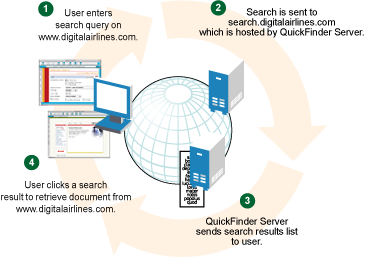1.2 OES Components That Provide Web and Application Services
OES comes bundled with all of the Web and application services components you need to host dynamic Web content and deploy Web applications that you can either build yourself or download from the World Wide Web. Some of these components are developed by the open source software community, while others are developed by Novell. Each component offers an important building block that lets you build the solutions that best meet your business needs.
The following diagram illustrates how you can combine open source software and Novell software to provide Web-based business solutions for employees, customers, and partners.
Figure 1-2 Open Source and Custom Built Solutions
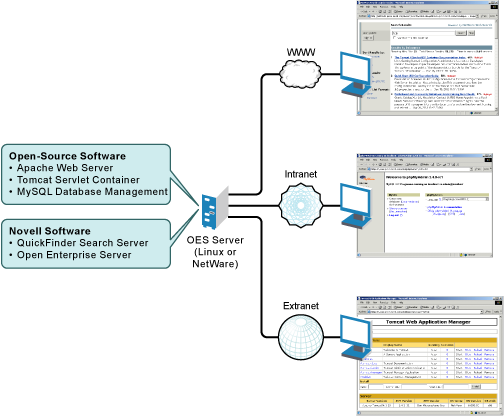
With the Web components available in OES, you can:
-
Host multiple Web sites on a single OES server.
-
Manage all instances of the Apache Web server from one interface using Apache Manager (regardless of what platform they are running on in your network).
-
Choose from hundreds of free Web applications that can be downloaded from the Internet and run on your OES server.
-
Build and host your own Web database applications.
-
Choose from popular scripting languages to build your own dynamic Web content.
-
Build powerful Web applications and services using the JBoss* or Novell exteNd Application Server, which includes SOAP and UDDI components, as well as rapid application development support and application deployment capabilities.
-
Add search and print functionality to any Web site, anywhere on the World Wide Web or on a company intranet.
Some of the key benefits OES has to offer in the area of Web and applications services include the following:
-
Open source components that help you steer away from vendor lock-in and proprietary solutions. Applications that you develop can run on any other J2EE compliant platform, including UNIX and Windows operating systems.
-
Valuable services for end users that enhance personal and team productivity.
-
A strong J2EE and open source development model.
-
A broad range of industry standard API sets.
-
A broad selection of development tools and deployment models for developers. This provides tremendous flexibility in those cases where IT organizations decide to repurpose their servers.
-
Lower IT spending because open source products are free and platform independent.
The following sections introduce each Web and application services component included with OES:
1.2.1 Web Hosting: Apache Web Server 2.0
Apache is the most popular Web server being used on the World Wide Web today. Its popularity comes from the fact that it is the most reliable and secure Web server available. It runs on all major platforms, is capable of hosting even the most complex Web sites, and can scale to handle thousands of simultaneous connections.
The Apache Web Server 2.0 serves as the foundation Web server upon which you can build Web sites and host Web applications for use in your business.
Key uses and benefits of using Apache in OES include the following:
-
It provides a highly reliable and fast Web server for hosting simple or complex Web sites.
-
It is preconfigured to work with Jakarta-Tomcat, the servlet container created by the Apache Foundation, which can be used to host servlets and JavaServer Pages (JSPs) for automating business processes.
-
It is ideal for Web application development and testing.
-
It lets you set up multiple virtual hosts for hosting multiple Web sites (with their own domain names) all from a single installation of Apache.
Figure 1-3 Apache Running on an OES Server and Hosting Multiple Web Site
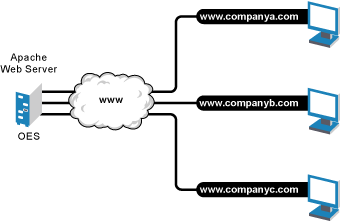
OES includes Apache Web Server 2.0 for both Linux and NetWare. It features a hybrid multi-process/multi-threaded implementation, filtering, simplified configuration, and a new API, along with extension modules to support Secure Sockets Layer (SSL), LDAP authentication, and multi-language error messages.
The NetWare version includes the following NetWare-specific features:
-
Tight integration with Novell eDirectory™ and SSL through the use of a customized NetWare-specific Apache module, providing a highly secure method for sharing sensitive company information over the Internet.
-
Compatible with the Novell exteNd Application Server for deploying Web applications and Web services.
-
The Apache Manager tool that lets you configure a single Web server, or a host of Web servers running on multiple platforms, all from a single interface.
1.2.2 Servlet Support: Tomcat Servlet Container
OES includes a Jakarta-Tomcat container for both Linux and NetWare. Tomcat is ideal for running basic Java servlet and JSP applications on either operating system platform. Tomcat 4 is the default version on both platforms. OES also includes Tomcat 5 for both Linux and NetWare, which implements the Java Servlet 2.4 and JSP 2.0 specifications.
If you are relatively new to, or inexperienced with, Java programming and do not plan to build more advanced J2EE applications, the Tomcat container should satisfy your needs. It is very stable and includes all of the features of a commercial Web application container.
OES NetWare includes a mod_jk connector module for integrating Apache for NetWare and Tomcat for NetWare. This module identifies requests that require the use of Tomcat. These requests are passed through the mod_jk module on Apache to Tomcat, as shown in the following diagram.
Figure 1-4 Tomcat and Apache Deliver Dynamic Web Content
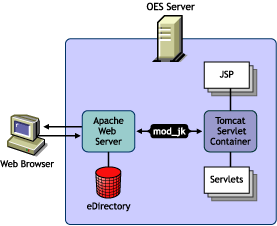
On NetWare, an administrative instance of Tomcat 4 is also installed for compatibility with other NetWare products and services.
1.2.3 Scripting: PHP, Perl, and Novell Script for NetWare
Scripting languages and visual builder tools have gained popularity in recent years because of their ease of use in delivering content to the Web. OES provides a choice of scripting languages and the engines to run them. You can use these tools to develop Web applications and administration utilities.
The scripting technologies integrated with OES for both Linux and NetWare include industry standard PHP and Perl.
NetWare includes additional scripting technologies that simplify the task of developing NetWare-based applications and is much easier than writing NetWare Loadable Module™ (NLM™) programs using C or C++.
-
Novell Script for NetWare (NSN): NSN is an object-oriented development environment designed to emulate the server-side use of Visual Basic* (VB). It incorporates predefined NetWare components with a VBScript syntax-compatible scripting language. This syntax compatibility enables developers to run scripts built on other platforms.
With NSN, you can write Common Gateway Interface (CGI) scripts, put intelligence into your Web pages, and build server-side task automation applications for NetWare. You can also develop Web pages using Microsoft FrontPage and publish them on a NetWare server.
-
Universal Component System (UCS): The UCS kernel exposes NetWare services to scripting engines regardless of the underlying scripting language. It allows you to write solutions combining NSN components, JavaBeans, Perl scripts, and other popular scripting and component languages. This means that Universal Component eXtensions (UCX), Java classes, JavaBeans, and remote ActiveX* controls can be used with NSN or Perl.
-
Novell ScriptPages (NSP): The NSP UCX component provides functionality similar to Microsoft Active Server Pages (ASP). NSP is a multi-object component that supports the Session, Request, and Response objects. NSP is currently supported only by Novell Script for NetWare.
1.2.4 Web Databases: MySQL
OES includes the open source MySQL database server on both the Linux and NetWare platforms. When combined with a Web application and a Web server, MySQL is a very reliable and scalable database for use in hosting eCommerce and business-to-business Web applications.
To manage your MySQL database, you can use the open source phpMyAdmin application written in the PHP language that provides a Web-based administration tool. NetWare installs a utility called MySQL Monitor by default when you install MySQL. This gives you access to the MySQL server through SQL commands.
The following diagram shows how MySQL can be used to host Web database applications such as eCommerce or inventory tracking.
Figure 1-5 MySQL and phpMyAdmin: Hosting Several Web Database Applications
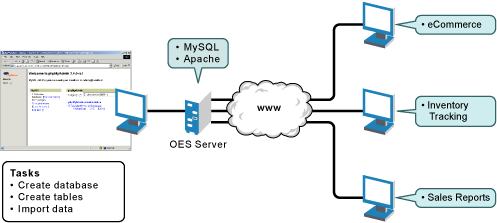
NOTE:The more powerful PostgreSQL database server comes with SUSE Linux Enterprise Server. It has been ported to the NetWare platform as well and is available separately as open source software.
1.2.5 Custom Web/J2EE Applications: JBoss and Novell exteNd Application Server
When you need greater processing power beyond what scripting or Web application hosting with Tomcat can offer, OES offers a choice of J2EE-certified application servers: JBoss and the Novell exteNd Application Server. These application servers are both comprehensive, J2EE-certified platforms for building and deploying enterprise-class Web applications. They support JSP, EJBs, and all other standard J2EE components and technologies.
-
JBoss: Bundled with SLES 9, JBoss provides enterprise-class security, transaction support, resource management, load balancing, and clustering.
-
Novell exteNd Application Server: On the NetWare side, the Novell exteNd Application Server provides the application hosting power you need to employ more sophisticated Web services using SOAP and UDDI. It includes high-end development tools such as the Novell exteNd Director™ or exteNd Composer™ products.
1.2.6 Web and Network Search Capability: QuickFinder Server
No Web solution is complete without capable searching functionality that provides users with a method for finding information they need, when they need it. That is why OES includes the Novell QuickFinder™ Server on both the Linux and NetWare platforms.
Novell QuickFinder Server lets you add search and print functionality to any Web site, anywhere on the World Wide Web or on a company intranet. You can use it on your own enterprise-wide Web site or to host search services for business partners or clients.
Visitors to your Web or intranet site enter search terms in the search form that you place on the pages of your Web site. The search term is used to find matches contained in indexes you create using the QuickFinder Server Manager, a Web-based management utility. Search results, including matching URLs, are sent back to the user's Web browser.
Figure 1-6 How QuickFinder Server Handles a User's Search Query
